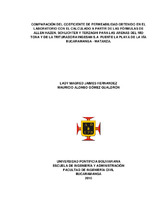| dc.contributor.advisor | Bautista García, Gerardo | |
| dc.contributor.author | Jaimes Hernández, Lady Magred | |
| dc.contributor.author | Gómez Gualdrón, Mauricio Alfonso | |
| dc.coverage.spatial | Seccional Bucaramanga. Universidad Pontificia Bolivariana. Escuela de Ingenierías. Facultad de Ingeniería Civil | spa |
| dc.coverage.temporal | 2010 | |
| dc.date.accessioned | 2013-08-28T16:59:48Z | |
| dc.date.available | 2013-08-28T16:59:48Z | |
| dc.date.created | 2010-02-17 | |
| dc.date.issued | 2013-08-28 | |
| dc.identifier.uri | http://hdl.handle.net/20.500.11912/965 | |
| dc.description | 86p.: (pdf); gráficas; tablas; anexos | spa |
| dc.description.abstract | En este proyecto de grado se analizaron dos (2) tipos de arena (Río Tona y Trituradora INGESAN), con un porcentaje menor al 5% de finos y que pertenezca al Departamento de Santander. Para verificar dicho porcentaje de finos se realizaron tres (3) ensayos de granulometría para cada una de las muestras de arena donde posteriormente se promediaron los resultados obtenidos. Con estos datos se realizó un análisis del tamaño de partículas del suelo donde se clasificó la arena de la Trituradora INGESAN al grupo SW (Arena Bien Graduada) y para la muestra del Río Tona una clasificación SP (Arena Mal Graduada). Una vez conocida la clasificación, se procedió a realizar 30 ensayos de permeabilidad y 30 ensayos de peso específico para cada muestra seleccionada la cual permitió comparar el coeficiente de permeabilidad obtenido en el laboratorio con las obtenidas a partir de las ecuaciones de Allen Hazen, Schlichter y Terzaghi, para posteriormente realizar el ajuste, el cual consistió en obtener las nuevas constantes, propias de cada arena y para cada ecuación, con el fin de disminuir el porcentaje de error. Las constantes obtenidas para el Río Tona fueron según Hazen (C=10.24), Schlichter (C= 79.62), Terzaghi (C1=10.244 y C0 = 43.09) y para la trituradora INGESAN según Hazen (C= 18.08), Schlichter (C= 44.04) y Terzaghi (C1= 18.08 y C0= 65.97); lo cual demuestra que no aplica según las ecuaciones originales propuestas por los autores. Posteriormente, se calculó el porcentaje de error existente entre el coeficiente de permeabilidad de laboratorio y el obtenido con las nuevas constantes para cada ecuación estudiada para verificar la viabilidad de cada constante hallada. | spa |
| dc.description.abstract | In this research two (2) types of sand samples were analyzed (Tona River and INGESAN Crusher), each of these from the Santander region and with a 5% percent less of fines. To establish these percentages of fines Granulometry tests were ran to verify that the sand accomplish the objectives, in this way, three (3) tests were realized for each sand sample and the results were averaged. A grain size test of the soil also has been developed, with a calculated percentage of gravel, sands, and fines particles. With this data a graphic was drawn. The curve allow to identify the D10 (mm), D30 (mm) and D60 (mm). Taking into account this particle sizes, it was defined certain grade features as, uniformity coefficient (Cu) and curvature coefficient (Cc). Through soil categorization criteria (Cu ≥ 6 y Cc = 1≤ Cc ≤ 3). In this way it was possible to know if the samples belong to SW (wellgraded sand) or SP (poorly-graded sand).
Once sands category were identified, 30 trials of permeability and 30 trials of specific weight tests for each test type and for each sample were ran. With this data constant contrast using Allen Hazen, Schlichter y Terzaghi formulas was done. The outcomes were adjusted to decrease error percentage (%) of the results. The constants obtained for Tona river were according to Hazen (C=10.24), Schlichter (C= 79.62), Terzaghi (C1=10.244 y C0 = 43.09), and INGESAN crusher according to Hazen (C= 18.08), Schlichter (C= 44.04) y Terzaghi (C1= 18.08 y C0= 65.97). The data above shows it does not apply to the original equations state by the authors. Finally, error percentage between the “k” obtain in the lab and the kadjusted was established, in order to verify the viability of the constant found. | |
| dc.language.iso | es | |
| dc.publisher | Universidad Pontificia Bolivariana | spa |
| dc.rights | Attribution-NonCommercial-NoDerivatives 4.0 International | * |
| dc.rights.uri | http://creativecommons.org/licenses/by-nc-nd/4.0/ | * |
| dc.subject | Tesis y disertaciones académicas | spa |
| dc.subject | Ingeniería civil | spa |
| dc.subject | Formulas de Allen Hazen | spa |
| dc.subject | Trituradora Ingresan S.A - Bucaramanga | spa |
| dc.title | Comparación del coeficiente de permeabilidad obtenido en el laboratorio con el calculado a partir de las fórmulas de Allen Hazen, Schlichter y Terzaghi para las arenas del río Tona y de la trituradora Ingesan S.A. fuente la playa de la vía a Bucaramanga - Matanza | spa |
| dc.type | workingPaper | spa |
| dc.rights.accessRights | openAccess | spa |
| dc.type.hasVersion | publishedVersion | spa |
| dc.identifier.instname | instname:Universidad Pontificia Bolivariana | spa |
| dc.identifier.reponame | reponame:Repositorio Institucional de la Universidad Pontificia Bolivariana | spa |
| dc.identifier.repourl | repourl:https://repository.unab.edu.co/ | |


